
Air Jordan 3 was created in 1988. Nike worked closely with Jordan to develop a comfortable, light shoe with an impeccable design. The AJ3 was one of the first models that did not have the Swoosh logo on the side and featured the visible Air unit.
The average sale price of this popular shoe is $233. Considering its high price point and immense popularity, the AJ3 is a prime target for counterfeiters.
Counterfeiters targeting Nike products have worked hard to refine their practices and recreate identical copies. They have become more proficient in copying the design elements, logos, and overall appearance of genuine Nike products. Therefore, recognizing counterfeit Nike products is more challenging.
Counterfeiters have gained insights into the nuances of Nike’s products, resulting in footwear that appears convincing at first glance. As counterfeiters advance their practices, consumers need to stay updated with the latest authentication methods.
How to tell if Jordan 3s are fake and avoid getting scammed? This practical authentication guide shares the methods to validate original footwear and provides step-by-step instructions!
Table of Contents
- The Packaging Method
- The Overall Look Method
- The Hang Tag Method
- The Stitching Method
- The Size Label Method
- The Heel Method
- The Outsole Logo Method
- How to Spot Fake Jordan 3 When Shopping Online
- Frequently Asked Questions
The Packaging Method
The legit check Jordan 3 starts with the packaging method. We look closer at the shoe box to determine if it is real or fake.
Jordan 3s come in a black box with the signature Jumpman logo printed on the lid and side. The style and color of the box vary through the years, so expect to see variations in purchasing older models.
Some counterfeit Nike shoes come sealed in a plastic bag without a shoe box. This sign is your first indicator of a fake product.
However, some come packed in a shoe box that appears identical to the original. But you can still discover some inconsistencies that give off a fake product.
Firstly, take a closer look at the Jumpman logo. This is usually where counterfeiters go wrong and don’t copy the exact design.
The Jumpman should be precise and have clean lines. The shoe laces and fingers should be well-defined in the original box, which indicates quality printing techniques.
Next, move to observe the overall quality of the box. Nike produces sturdy boxes that will protect the shoe. Check if the lid has thick edges and appears sturdy.
The shoe box label is another indicator of a fake product. Even though the placement of the text is identical, you can still notice inconsistencies.
Counterfeiters fail to copy the same font, so the letters and numbers will vary in size and thickness. Also, the Jumpman logo won’t be as detailed as the original.
The Overall Look Method

When we’re done inspecting the box, we move to the overall look method. The leather print on the heel counter is a signature style of this model.
The authentic shoe has a detailed leather print with a distinctive texture. On the other hand, the counterfeit model seems to have done a lousy copy. It lacks texture and has darker colors than the original.
For further authentication, we move to the upper part of the shoe. We can notice a significant flaw in the fake model.
The authentic Jordan shoe has an eyelet near the collar. With this, you can lace the shoe and define the signature look.
The counterfeiters seem to miss this important detail when creating their replicas. The holes aren’t pierced, so this element loses its function.
The Hang Tag Method
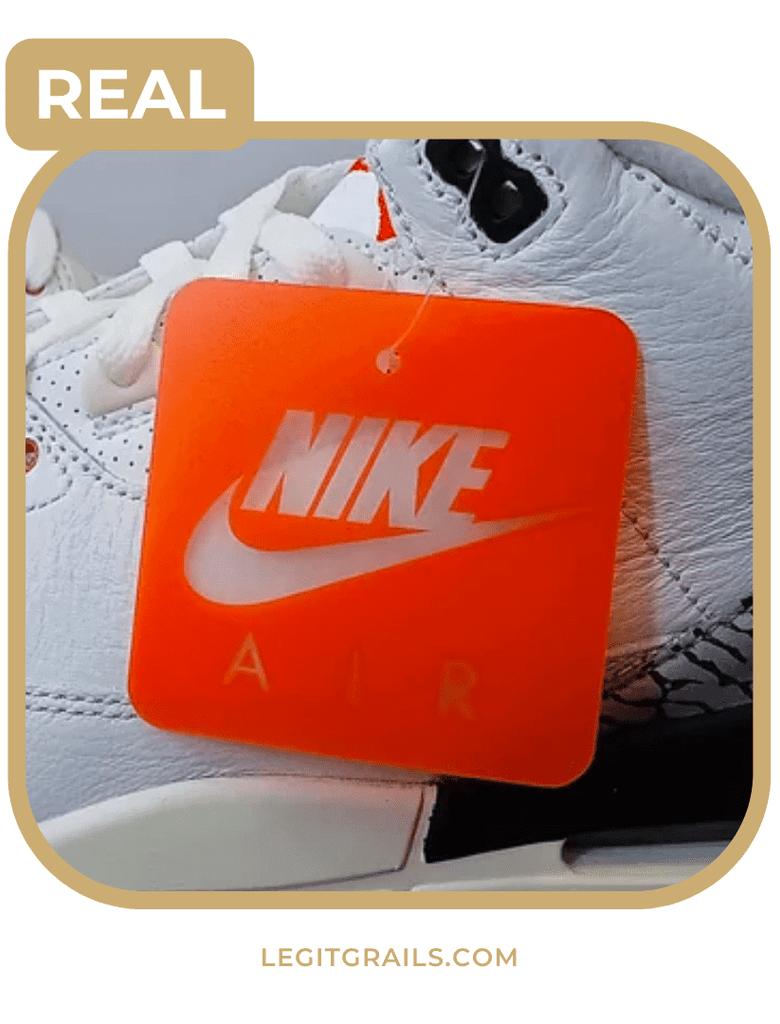
An original Nike Jordan 3 comes with a hang tag. The clear tag has the Nike logo embossed, along with the Jumpman and “ AIR” logo.
A fake product might lack the hang tag. But if it comes with the tag, you can further analyze the logo to discover inconsistencies with the real model. The difference in letters and details on the Jumpman can give off a fake shoe.
However, remember that the hang tag is removable and might be misplaced. If buying second-hand shoes, they might come without the label, which does not necessarily have to indicate it is a fake product. In that case, apply the other methods in this authentication guide.
The Stitching Method
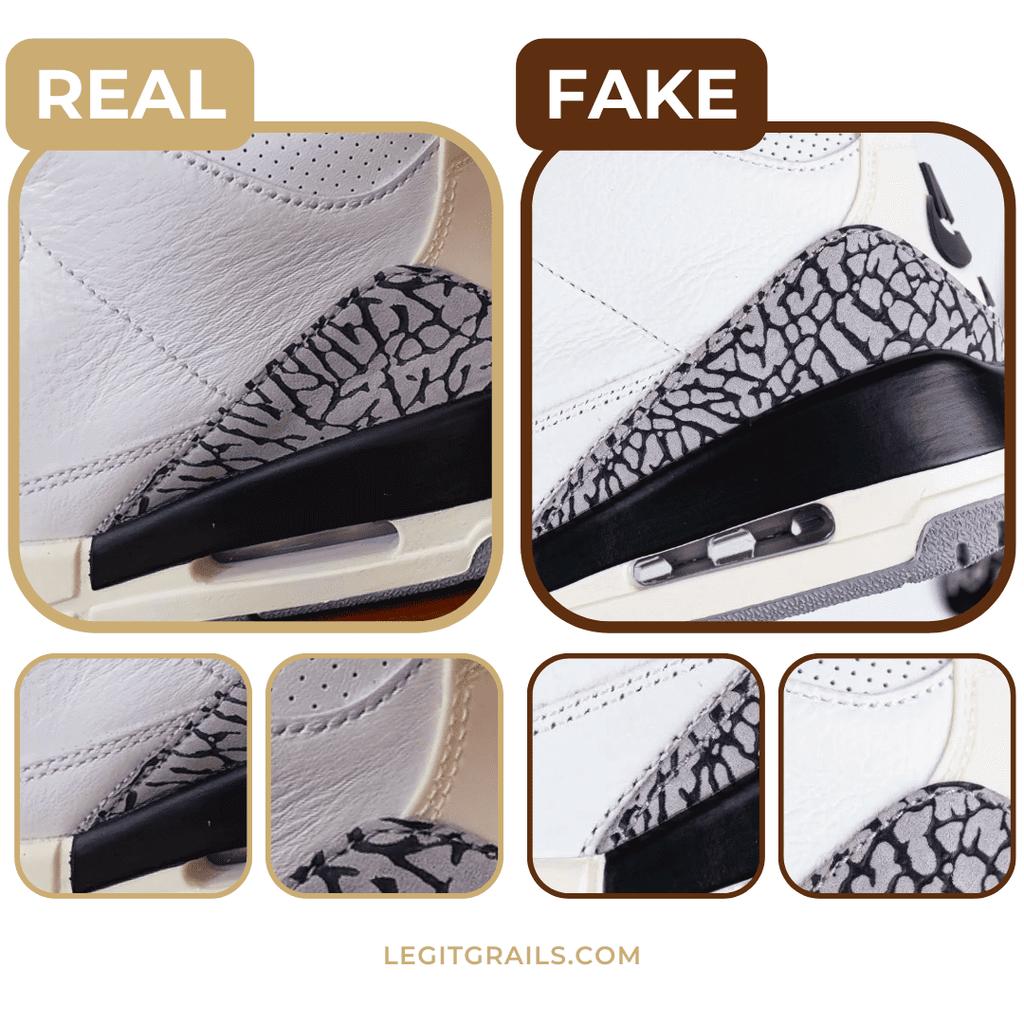
As we move further to inspect the shoe, we look into the fine details. How to tell if Jordan 3 is fake by observing the stitching quality?
From our authenticating experience, we can confirm that bad stitching quality is present in all fake Nike footwear. This can be explained by the fact that counterfeiters don’t use sophisticated equipment as a big brand does. Consequently, the stitching quality will differ.
Genuine Jordan 3s have even stitching and streamlined seams. On the contrary, the fake model has small stitching lines with gaps between them – which can be used to tell fake vs. real Jordans.
The Size Label Method
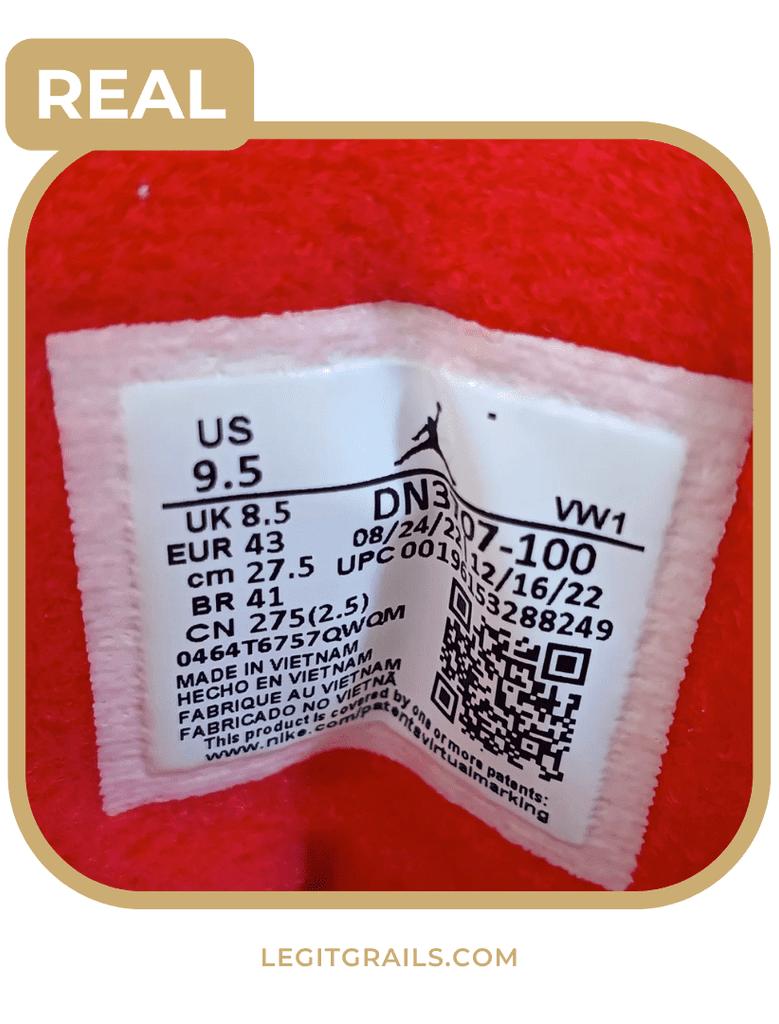
For the next step, we inspect the inside of the shoe. Here you can find the size label to legit check Jordan 3.
How to tell if Jordan 3 is fake by comparing the size labels? Firstly, you can notice a difference in the letter thickness. Also, watch out for improper spacing between the letters.
The fake tag has thinner or thicker letters than the original. Also, the QR placement can differ.
The Heel Method
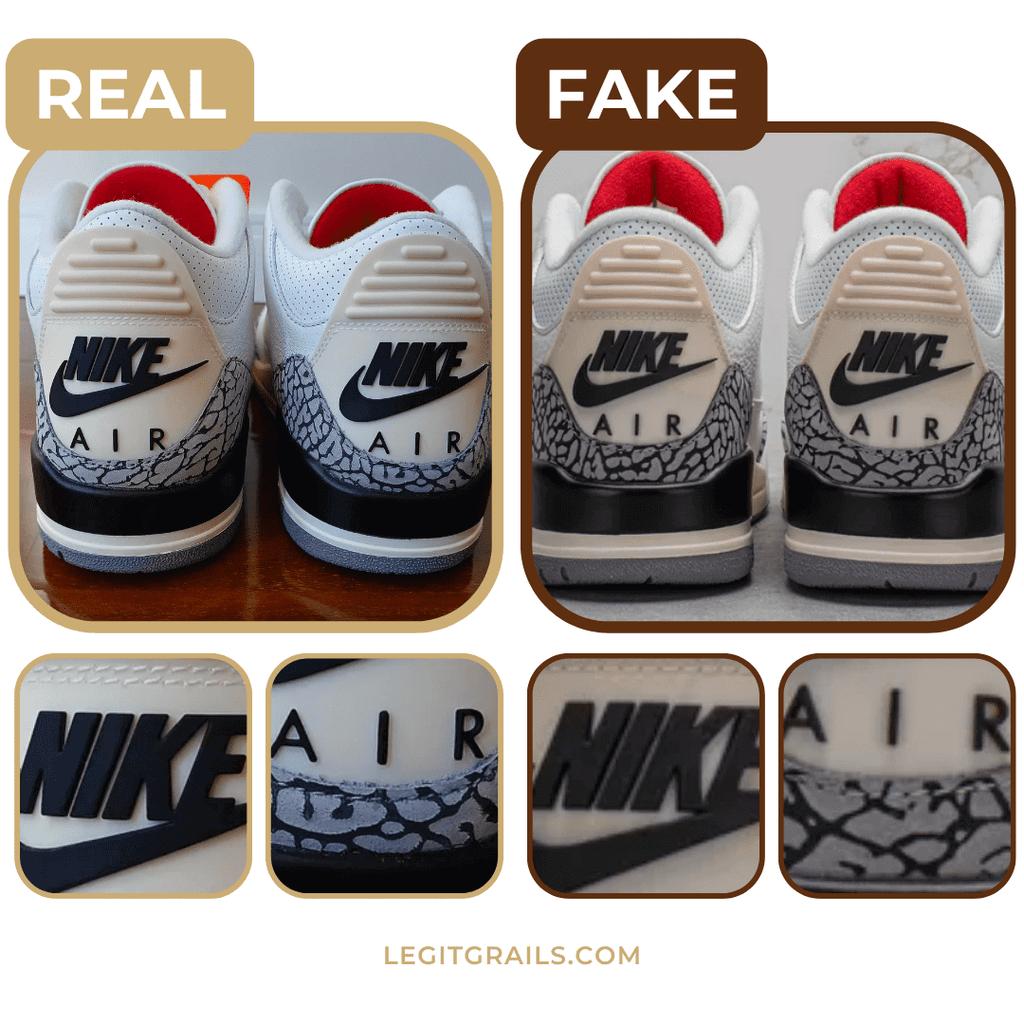
We move to the heel method to further inspect and reveal how to legit check Jordan 3. We instantly spotted a few inconsistencies that tell a clear difference.
Starting from the Nike logo, there is a clear difference in quality. The original shoe comes with a precisely crafted logo with a bold navy color.
The fake Nike Jordan 3 doesn’t follow suit. The Nike logo looks faded and doesn’t have an intense color like the original. Also, we can notice that the letters are not precisely cut.
The “AIR” logo is another indicator of a fake product. The real logo has thick letters that stand out nicely against the white material. On the other hand, the counterfeit model has thin and pale letters.
The “AIR” logo placement is another thing to consider when authenticating your pair. In the original, the logo sits just above the leather print seam. At the same time, the fake logo has a larger gap between the logo and the stitching.
The Outsole Logo Method
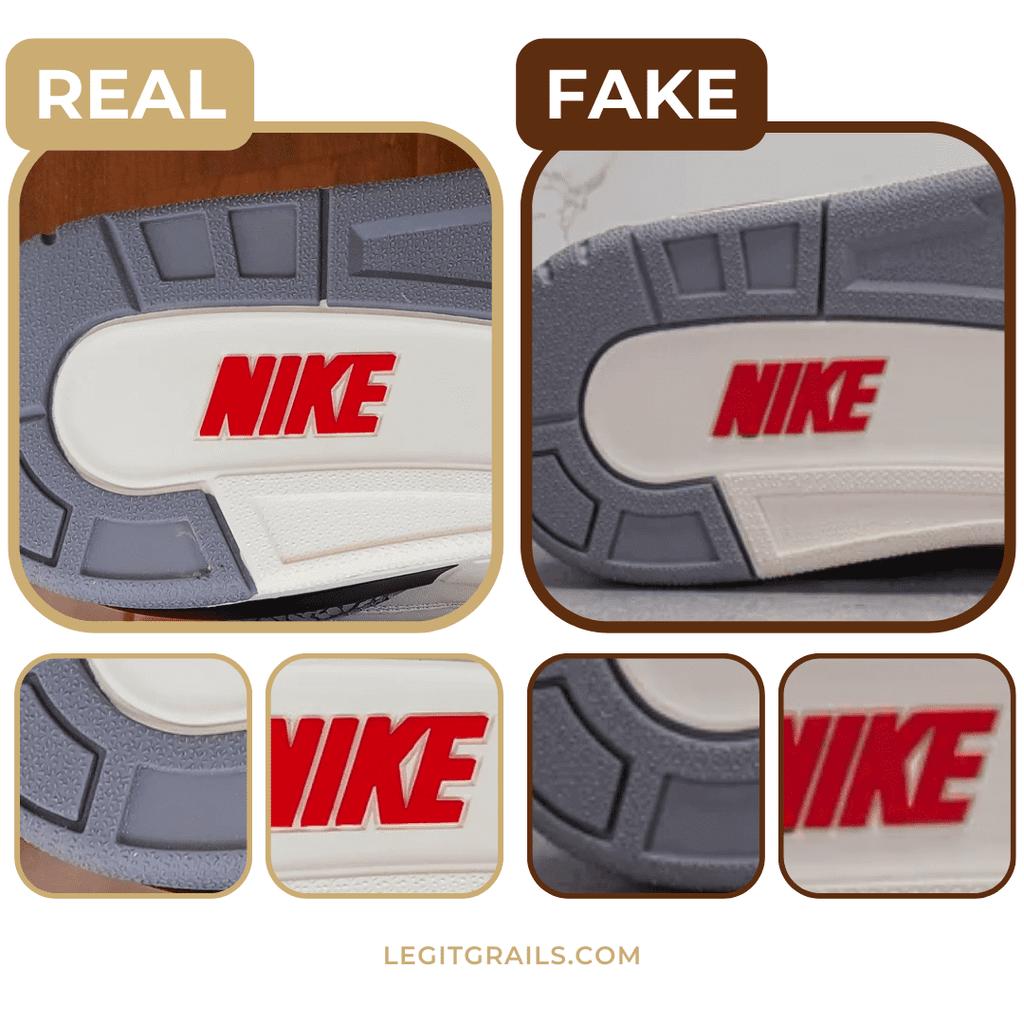
How to tell if Jordan 3 is fake by looking at the outsole logo? We can instantly spot a difference in carving and quality.
The counterfeit Nike outsole shows subpar craftsmanship, which can be noticed through the pattern and logo. When closely examined, the outsole pattern lacks the precision and finesse that are characteristics of authentic Nike products.
The uneven edges and shallow carving give off a fake model, while the overall finish is rough and inconsistent.
Furthermore, we inspected the Nike logo embossed into the outsole. The original has a bold red color and precise edges. The well-defined bold lettering stands out nicely, representing the brand’s consistency.
Whereas they look pale and faded on the fake one. The color and depth suggest a lack of attention to detail and quality control during manufacturing.
How to Spot Fake Jordan 3 When Shopping Online
Since Jordan 3 are costly, you might be delighted with the great deals you’ve found online. While there are chances to find genuine sneakers for excellent prices, you must be careful and avoid being scammed.
Shopping from authorized resellers is the safest option, but you still might find better deals from individual sellers. In such cases, consider a few extra steps in the process.
Price is too low
Scammers often use low prices to lure customers into purchasing counterfeit goods. While you will save money, you won’t have the quality and craftsmanship of a genuine Nike product.
Do market research to determine the average price for the brand new or second-hand Jordan 3. Anything way lower than that indicates a counterfeit product.
No images
An online listing that offers genuine Jordan 3 should come with decent pictures. High-quality photos and close-ups help you distinguish between fake and real shoes. If the listing has blurry or fewer images, this could mean they are trying to hide the imperfections.
As seen in our authentication guide, we relied on high-quality images to identify the inconsistencies in real and fake models. A seller that offers genuine products wouldn’t mind sharing high-resolution pictures that showcase the stitching, logos, and fine details.
Lack of product information
A legit seller provides detailed information about the product they’re selling. An accurate description that includes the material, sizing, and features offers valuable information so the customer can make final decisions.
If you have any doubts about the product, the seller should be open to resolving them.
Bad seller reputation
For the next step, we move to the seller’s profile. A quick analysis can tell us whether they’re a reputable and honest seller.
Check the feedback and rating indicated on their profile. If there are any negative reviews, be sure to check them. See if the seller has had any issues with selling counterfeit products before.
Frequently Asked Questions
Does Jordan 3 come with tags?
Authentic Jordan 3 has a distinctive tag attached to the left sneaker on the top eyelet. The Swing tag is made of transparent plastic and has a square shape. The Nike Air logo is embossed in the material.
The original Jordan 3 came with this removable tag, which can be misplaced. You might receive second-hand shoes without the tag if you’re purchasing second-hand shoes.
In addition, counterfeiters can create replicas of the tag. An original Swing tag has a red printed front and round edges. Also, it comes with a quality silver ball chain attached to the eyelet.
The logo’s font, size, and proportion should align with Nike’s branding. Any inconsistencies could indicate a counterfeit replica.
Are Jordan 3 still popular?
Jordan 3 is a famous shoe that will never go out of style. While it might not be the first choice for the court, it is a modern everyday shoe. With four decades on the market, it won’t go out of fashion anytime soon.
Do Jordan 3s get creased?
Jordan 3s can get creased, and this is normal with frequent wearing. As you take a step, the toe box material compresses, and wrinkles will appear. While you can’t prevent the creases, you can still ensure a pristine look.
The official Nike website shares instructions for increasing shoes. They suggest methods like ironing, steaming the shoes, blow drying, and conditioning. The options are safe for leather shoes and will keep your Jordan 3 pristine longer.
Conclusion
This authentication guide explains how to tell if Jordan 3 is fake. We relied on a few proven methods to confirm authenticity.
Firstly, we start with the packaging method. Inconsistencies in quality, color, and label design indicate a fake product.
Furthermore, the overall look reveals flaws in fake vs authentic shoes. The leather print and eyelet are the focus, indicating poor manufacturing quality in the fake shoe.
The stitching method shows inconsistency in quality. The real Air Jordan 3 has even and dense stitching, while the fake has small stitches.
The hang tag is another point of interest in this guide. A good quality tag without logo inconsistencies indicates an original product.
For the size label method, we compared the letter sizing and thickness. The fake model can have thinner or thicker letters, unlike the original.
When analyzing the heel, we discovered logo flaws. The pale color and lack of precision are telltale signs that reveal fake sneakers.
The outsole method provides valuable insights into how the original should look like. The fake outsole lacks carving precision, so the pattern differs. In addition, the logo lacks color.
Even with these precautions, you might still be uncertain about the footwear’s authenticity. In which cases it would be best to get professional authentication services. All you need to do is provide a few photos of the product, and experts will take care of it.

